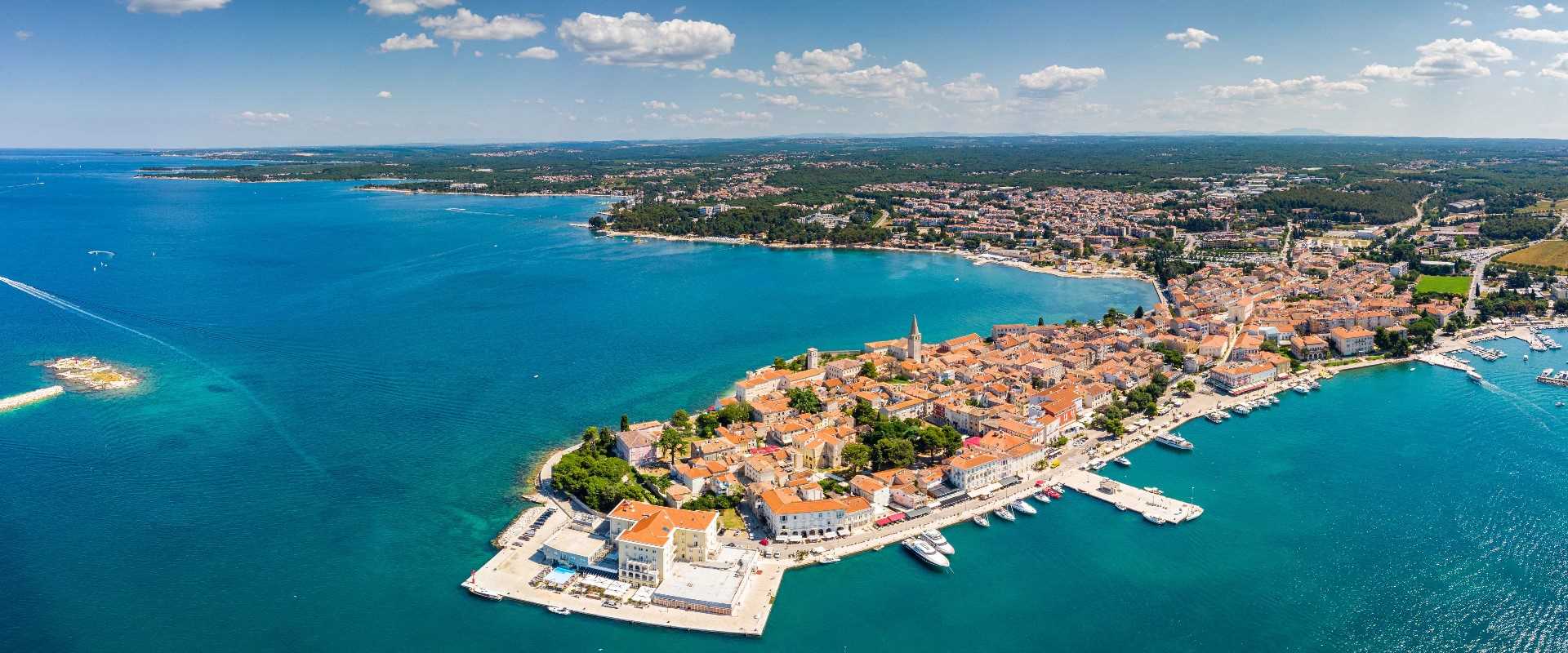Istria has rolling wide valleys and gentle hills, perfect for wine and olive oil cultivation (it regularly wins international awards for both) and truffles. The cultural legacy is complex but is entwined with Italy (and until World War II this small, heart shaped peninsula was Italian). Especially on the west coast of Istria, it feels and sounds very Italian with almost everyone speaking Italian as well as their native Croatian. The architecture will remind visitors of Italy, specifically Tuscany with some stunning hilltop villages such as Motovun and Groznjan. From Pula, Rovinj and Porec a daily catamaran reaches Venice in just under two hours. Trieste is just a 1 hour 20-minute drive from Porec.
Istria (Croats call it Istra) gets its name from the Histri, an Illyrian tribe which ruled before succumbing to the Romans in the second century BC. The Romans built amazingly straight roads together with the awesome amphitheatre in Pula, built towards the end of the 1st century BC, it is immense and is the sixth largest amphitheatre in the world. This is no ruin, it is completely intact and is a venue for many events and concerts each year. The Romans, quite understandably, christened Istria “Terra Magica” (magic land).
Istria has no inhabited islands (other than two tiny ones with one hotel on each), however, it is home to one of Croatia’s most beautiful national parks, the stunning Brijuni islands – so the islands that Istria does have are especially memorable – and certainly unique. This archipelago is made up of 14 small islands and islets. And they are very special islands indeed, some visitors say that they are straight out of a film set. The largest island Veli Brijun is open to the public and can be reached from Fazana on the mainland by passenger ferry taking 15 minutes. In August, visitors may also go to Mali Brijun Island if there is a concert or performance there during the wonderful Ulysses Festival when the ticket price includes the boat trip.
On Veli Brijun, there are just a couple of hotels and luxury villas. A car free island, the other residents are deer, peacocks and rabbits which roam wild and the animals that live at the open Safari Park.
Most visitors from the UK arrive at Pula airport or from Venice on a twin centre break. There is also a domestic flight between Split and Pula twice a week which offers possibilities for a twin centre break in the Dalmatia region too.
Pula rejoices in a mix of Roman heritage, a Communist past and the beautiful green peninsula of Verudela which has sea on three sides and is just 15 mins from the centre of Pula. Our hotels Park Plaza Histria and Park Plaza Arena are located here while the small, boutique Hotel Amfiteatar is, as the name suggests, around a three-minute walk from the magnificent amphitheatre.
Pula is a wonderful mix of real town with history and a holiday resort out at Verudela with some fabulous boat trips to Cape Kamenjak (often used as a film location) – and of course, the Brijuni National Park.
The centre of Pula is an overload of Roman history including the Arch of the Sergians, Roman Forum, Temple of Augustus and more. Not to be missed is coffee time on Giardini, a completely tree lined canopied avenue - terrace that is utterly Mediterranean.
Continuing northwards along the west coast of the Istrian peninsula, visitors arrive in Fazana, a small picture-postcard seaside village that is unique. Think a heritage of sardine fishing, beautiful pastel buildings, the departure point for Brijuni and some rather lovely white pebble beaches. Our exquisite featured hotel is the Villetta Phasiana with just 21 rooms, right in the centre of Fazana and once on Brijuni, our featured hotels are Neptun or the Istra. A holiday on Veli Brijun is unique and guests have unlimited free tickets across to Fazana.
40 minutes north, Rovinj is one of the most famous places in Istria which was once an island until the strait separating it from the mainland was filled in in the mid-18th century. It is quite stunning yet worth remembering that the old town is set on quite a steep hill. On the hilltop there are lovely views from the Cathedral of St Euphemia. We feature the Island Hotel Katarina, officially a three star but few would believe that- a truly wonderful location on an island five minutes from the centre of Rovinj with outdoor pools and hidden beaches, just wonderful.
Just 15 minutes from the centre of Rovinj along the seaside promenade “lungomare”, the Zlatni Rat wood and green area are home to our five-star Hotel Monte Mulini. Rovinj is breathtakingly beautiful.
If visitors are seeking an alternative to the hilltop core of Rovinj, then perhaps Porec is the spot? Another town with a Roman core and not to be missed are the sixth-century Basilica with wondrous mosaics, the Decumanus street designed the width of ten marching soldiers, the ruins of the temples of Neptune and Mars. In the old town look out for towers – round and pentagonal. Boat trips offer dolphin sunset cruises and trips along the coat. There is a beautiful seaside promenade passing small pebble coves and through pine woods. Our hotel the Bo Palazzo stands on a promontory in possible the best location in town while Mauro is a small stone building that was once the local police station and literally backs onto the old town centre.
Inland Istria is much talked about for its traditions, beautiful hilltop villages and truffles!
This really truffle heaven (the white are more prized than the black). “Truffle Central” is a tiny place called Livade and there are several truffle places nearby where visitors can learn about this food, have tasting or even go out with a truffle hunter and his or her very special truffle hunting dog. In Istria expect to find truffle in many dishes, including ice cream. Our featured hotel San Rocco in Brtonigla is on the doorstep of Livade so to speak, while minutes away in the tiny village of Nova Vas, Cattunar Wine Residence is a great place to stay for wine lovers. The Istrian wine story is worth hearing and the white Malvasia and red Teran, both indigenous from this region win awards including from Decanter of London.
For the active, there are excellent walking and hiking trails, horseriding along the Mirna River valley and an exhilarating bicyle ride along the route of the former Parezana railway line which connected Venice with Porec and now a tarmac narrow road for cyclists. Water sports are on offer from June to September – and then there is that very special Adriatic Sea.
Did you know?
- Archaeologists claim that over 70% of Pula contains Roman ruins and artifacts if it were all dug up.
- Croatia’s first Michelin star restaurant was Monte in Rovinj. It still holds the star and has been joined by Agli Amici which also has one star. La Puntulina and Cap Aureo in Rovinj are Michelin recommended.
- The hilltop village of Motovun hosts a five-day film festival in July. Easy to visit from anywhere in Istria and a great place to watch films against the town’s walls.
- The east coast of the Istrian peninsula offers one of the most beautiful drives in Croatia passing through Labin (a mining place until 1977 – visit the hilltop village and the mining exhibition) with views over to the Kvarner Bay islands of Cres and Krk.
- Porec Summer Festival is one of the most varied events in Croatia. Running from June until September, with many events outdoors, there are wine fairs, jazz concerts, open-air theatre and dance events and the wonderful “cinema under the stars” in the grounds of the Villa Polesini.
- One of the most famous chefs in Croatia, David Skoko owns “Batelina” a restaurant in Banjole near Pula. He creates and cooks and his dad still fishes. Focussing on the “poorer blue fish”, there is little else like it. Gordon Ramsey filmed there in 2021 and declared the place “close to a miracle”. (Closed in August, reservations essential, cash only).
- A month-long truffle festival takes place in and around Livade and Buzet each October. Tasting, group truffle hunts, cookery demonstrations and gourmet meals, music and dancing.





